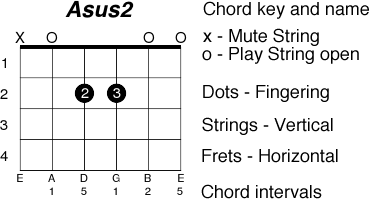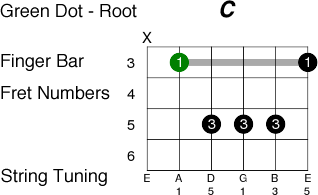Understanding Chord Diagrams


Chord Legend
Chord Name - The very top label of the chord diagram names the Key and the chord type.
O - If there is an O at the top of the string you need to play/pick that string open when strumming the chord.
X - If there is an X at the top of the string you shouldn't play/pick that string when strumming the chord.
Black Dots - The black dots on the chord diagram represent the fingers of your fretting hand. The numbers inside the dot represent the finger of your fretting hand. Fingers ( Index = 1, Middle = 2, Ring = 3, Pinky = 4, Thumb = T )
Fret Numbers - The numbers listed vertically on the left side of the fretboard represent the frets you should place your fingers on to play the chord correctly.
String Letters - The letters at the bottom of the string represent the open pitch of the string. This helps to identify the tuning of the instrument.
Interval Numbers - The numbers underneath the string letters are the intervals in the chords. See the music theory section for more information on this concept.
Bars - Some chords contain gray bars. This means you should bar across that fret with 1 finger. These generally occur on moveable chords.
Root notes - The green dots are root notes. This means that the chord is moveable and by shifting up or down the fretboard you can change the key of the chord without changing the chord type or pattern. This brings out the true power of chords on stringed instruments. Learn 1 chord pattern or type and you know them all. You just have to put it on the right fret to match the key you want.